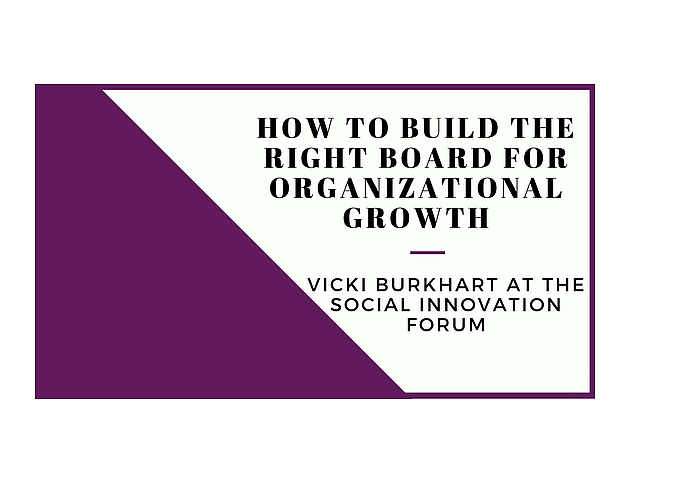
On February 14, the Social Innovation Forum hosted a workshop: How to Build the Right Board for Organizational Growth, with Vicki Burkhart, the non-profit growth strategist leading the Burkhart Group. The workshop included nonprofit leaders and board members from SIF's alumni portfolio, coworking members, and Social Innovator Accelerator Finalists. Here are some key takeaways.

Vicki Burkhart, the non-profit growth strategist leading the Burkhart Group.
Building The Right Board: The Big Things
Create a Board Development Committee
-
Vicki began the session by suggesting that every successful board needs a Board Development Committee. Unlike a Nomination Committee, this should be an ongoing group that continues beyond elections to focus on leadership growth and strategic planning. Board Development Committees look at all board-related positions in the organization, beyond just Board Chair and other leadership positions. This committee is responsible for creating position descriptions for each board position, onboarding and mentoring new board members, and maintaining and strengthening the entire board structure for the long-term (including succession planning!).
Your board should be your vision.
Create a Board Map
-
Engaging your board in a board mapping exercise is an excellent way to plan your board's development, and Vicki shared examples of how an organization might use this tool. First, identify what skills and qualities are essential to the future of your organization, keeping in mind that, "your board should be your vision." Then, create a chart to identify which of those skills your board members have, and which skills you are missing. Use that skill gap as your road map to finding new board members. You might also discover your current board members have hidden skills you didn't know about!
Build a Pipeline
- Vicki encouraged attendees to begin an outreach campaign to identify, cultivate, and recruit prospective board members, with the assistance of the board map. Connect with these people regularly, invite them to events at your organization, and talk about your organization's goals and mission. This pipeline can serve as an extremely helpful resource to call on in times of transition and is a good way to think about expanding current networks to increase the diversity of your board members. Utilize current and past board members, donors, volunteers, civic organizations, corporate community relations offices, and the communities your organization serves to fill your pipeline.
Write Clear Position Descriptions for Each Board Member
- Many of us might have experiences where a board member doesn't seem to meet the expectations of the Executive Director or staff. One reason for this, Vicki revealed, is because boards lack well-defined position descriptions that include expectations around giving, attending events, and other responsibilities. Your board needs agreed upon sets of expectations to hold members accountable for their roles and responsibilities and to help potential board members determine if they have the capacity to fully commit. This position description should include term lengths and limits, time commitment expectations, and responsibilities outside of board meetings. This document can also be helpful when reflecting on board members' performance in framing conversations about stepping up...and stepping down.
Implement an Effective Onboarding Process
- Effective onboarding strategies are critical to the success of strong boards. This process should begin long before the election, by inviting potential candidates to events and introducing them to your current board, which creates a runway of relationship building leading up to the election. An onboarding package and orientation program should include an explanation of a clearly defined position description. Matching up new board members with more experienced mentors on the board can be extremely helpful in creating community and accountability. The onboarding process should also include a six-month check-in, to review the position description, evaluate successes and integration onto the team, and to clarify and redirect with purpose.
Assess, Evaluate, & Improve for the Future
- Board development must include reflection on your work and processes to evaluate a board's effectiveness. Are your members committed, engaged, and held accountable? Are your tasks and responsibilities completed on time? Is your organization heading in the direction you want it to? Taking time to step back and asses your board's status is essential for planning an effective future.
And Finally, Have Some Fun
- Vicki reminded all of us that serving on a board should also include having some fun! A strong and connected board is essential to the success of your organization, but board members should also consider it "an honor to serve" and should enjoy the opportunity to be connected to your organization's mission and important work. Building a sense of community will make members excited to attend and engage in board meetings and other activities within the organization. Encourage your board members to be engaged and look forward to your meetings by having dinner or drinks before/after your meetings, plan retreats where members can fully focus on strategic planning, or host summer BBQs to get to know each other's families. Your board members are volunteers who dedicate their time because they truly care about your organization's mission. Create time to foster and deepen the underlying passion you all share for your work.
To learn more about board development or set up a training at your organization, contact Vicki Burkhart of the Burkhart Group at vsb@burkhartgroup.com.
 Social Innovation Forum
Social Innovation Forum